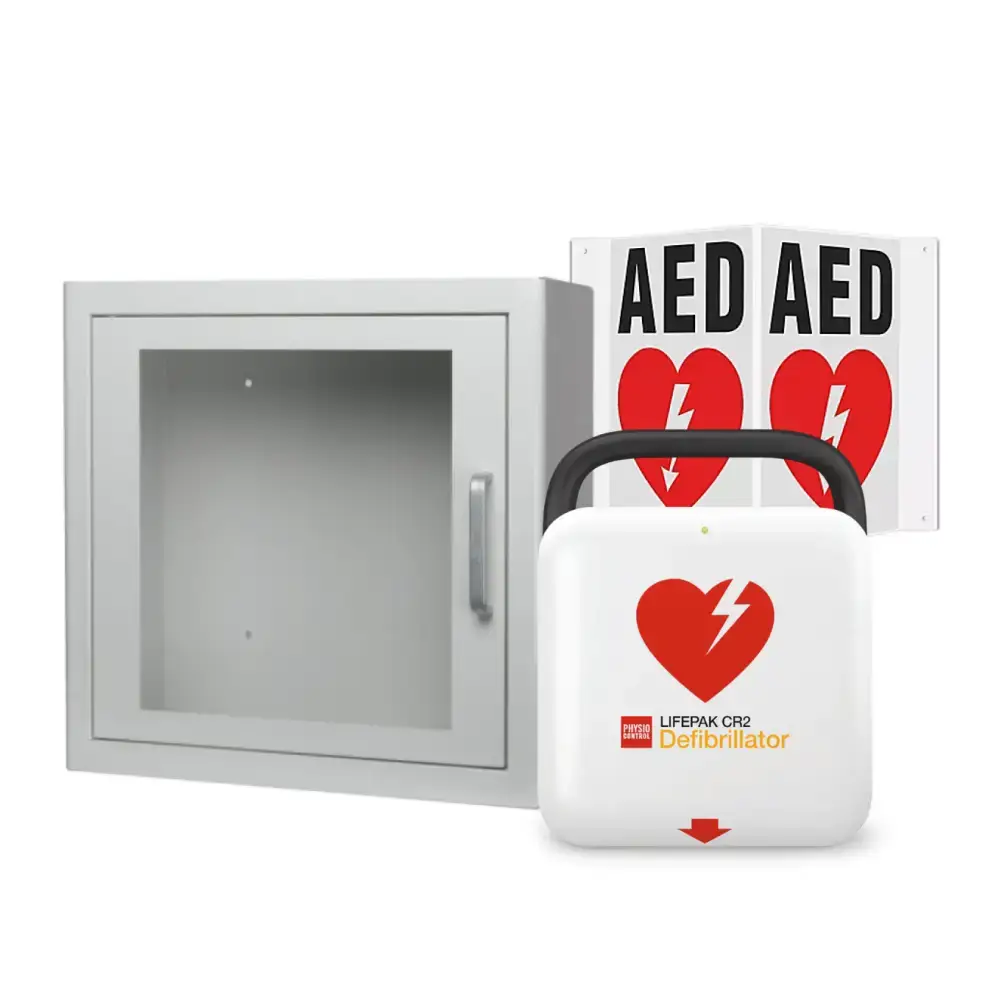AEDs are Literal Life Savers
Each year in Canada, approximately 50,000 cardiac arrests occur outside of hospitals, with survival rates as low as 5% without immediate intervention. When seconds count, having an Automated External Defibrillator (AED) on-site can be the difference between life and death. Is your building equipped to handle a cardiac emergency?
What Is an AED and Why Is It Critical?
An Automated External Defibrillator (AED) is a portable, user-friendly electronic device designed to analyze heart rhythms and deliver an electric shock when necessary to restore normal heart function during sudden cardiac arrest. These life-saving devices are engineered to be used by virtually anyone, even those with minimal training.
For every minute that passes without defibrillation after cardiac arrest, survival chances decrease by 7-10%. By having an AED readily available, you can significantly improve survival outcomes before emergency medical services arrive.

https://aed.ca/collections/bundles/products/physio-control-lifepak-cr2-package
The Canadian AED Landscape: Are We Prepared?
Despite growing awareness, many Canadian buildings remain without AEDs. Current statistics reveal:
- Only about 20% of public buildings in Canada have accessible AEDs
- Areas with AED programs have witnessed survival rates increase to over 70%
- Workplace cardiac incidents account for approximately 15% of all occupational fatalities
Many provinces are now implementing AED registry programs to track these vital devices, but coverage remains inconsistent across the country.
Legal Considerations and Requirements
While not federally mandated in all buildings, several provinces have enacted legislation encouraging or requiring AED placement in certain facilities:
- Ontario Bill 141 is the Defibrillator Registration and Public Access Act, 2020. This new legislation will increase public access to life saving AEDs. The bill is currently with the Ministry of Health to develop the necessary regulations.
- Manitoba requires AEDs in designated public places including gyms and community centers
- British Columbia has implemented AED requirements for many high-traffic public buildings
Even without explicit mandates, business owners should consider their duty of care obligations and potential liability issues. Having an AED demonstrates commitment to safety and risk management.
The Business Case for AED Installation
Beyond the ethical imperative to protect lives, installing AEDs makes sound business sense:
- Risk Management: Reduces liability and demonstrates due diligence
- Insurance Benefits: Many providers offer premium discounts for AED-equipped facilities
- Employee Confidence: Creates a safer workplace environment
- Public Perception: Enhances corporate social responsibility profile
- Customer Safety: Provides peace of mind for clients and visitors
Selecting the Right AED for Your Building
When purchasing an AED, several factors should be considered:
Types of AEDs Available in Canada
- Fully Automatic AEDs - Deliver shock without user intervention
- Semi-Automatic AEDs - Require the user to press a button to deliver shock
Key Features to Consider
- Ease of Use: Voice/visual prompts and simple operation
- Maintenance Requirements: Battery life and pad replacement schedules
- Pediatric Capabilities: Appropriate for both adults and children
- Data Recording: Event documentation for medical professionals
- Durability: Resistance to environmental factors
- Warranty Coverage: Protection for your investment

https://aed.ca/collections/bundles/products/zoll-aed-3-package
AED.ca: Canada's Premier AED Solution Provider
When seeking the best AED solutions for your Canadian facility, AED.ca stands out as the industry leader. With comprehensive offerings including:
- Expert Consultation: Personalized recommendations based on your specific needs
- Training : Specialized AED Training
- Maintenance Services: Regular checks and updates to ensure functionality
- AED Program Management: Complete oversight of your AED investment
- Nationwide Support: Service coverage across all Canadian provinces
Implementation Steps for Your Building
- Site Assessment: Determine optimal locations for AED placement
- Device Selection: Choose the appropriate model for your needs
- Staff Training: Ensure key personnel understand AED operation
- Emergency Response Planning: Integrate AED use into safety protocols
- Registration: Add your device to provincial AED registries where available
- Maintenance Schedule: Establish regular inspection routines
- Signage Installation: Clear AED location indicators throughout the facility
The Impact of AEDs: Real Canadian Success Stories
Across Canada, AEDs have proven their value countless times:
"After our company installed AEDs following a risk assessment, we never expected to use one so quickly. Six months later, when a visitor collapsed in our lobby, our receptionist used the device before paramedics arrived. The emergency room doctor later told us that without the AED, the outcome would have been tragic." - Toronto Business Owner
Similar stories emerge regularly from schools, community centers, fitness facilities, and workplaces nationwide.
The Cost of Inaction vs. Investment
While the initial investment for quality AEDs cost approximately $2,500, this pales in comparison to the potential human cost of not having one available during a cardiac emergency.
Consider also the potential legal and financial ramifications of failing to provide reasonable safety measures in your facility. Many organizations find that working with a trusted provider like AED.ca offers not just equipment, but peace of mind through comprehensive service packages.
Conclusion: A Critical Safety Decision
Installing an AED in your Canadian building isn't just about compliance or risk management—it's about creating environments where people can feel secure knowing that life-saving equipment is available if needed.
With cardiac events remaining a leading cause of death in Canada, the question isn't whether you can afford to install an AED, but whether you can afford not to.
Take the first step toward creating a heart-safe environment by contacting AED.ca today for a consultation and discover how simple it can be to protect the people who matter most—those who live, work, and visit your building every day.
AED Toronto, Toronto AED, AED Ontario, AED Ontario, AED Safety, Defib, CPR, First Aid






